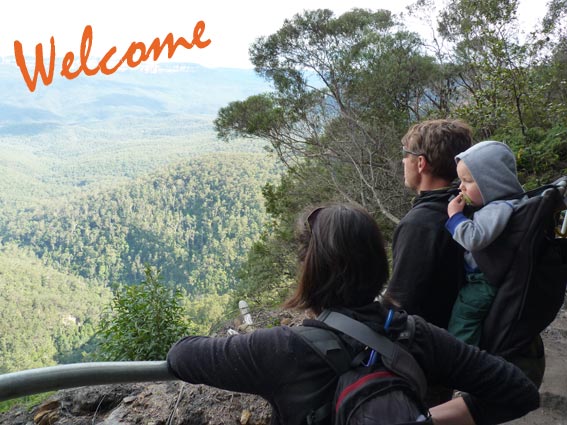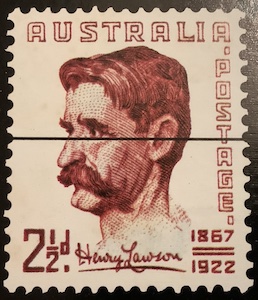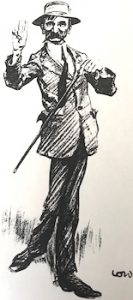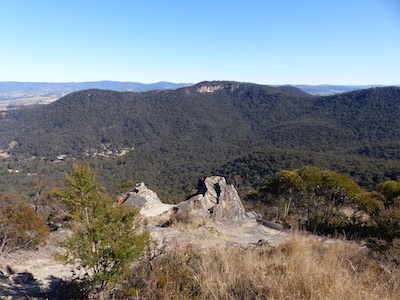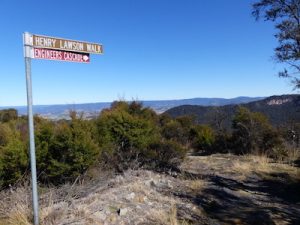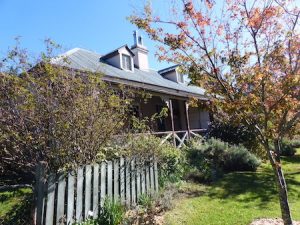Henry Lawson Rock, Mount VictoriaThere is a statue of the Australian poet and writer Henry Lawson in the Sydney Domain. Fixed to one place, it could be considered an uncharacteristic representation of a man who moved about so much during his life. High in the Blue Mountains at Mt Victoria there are other memorials to Lawson. On a cliff edge above the Kanimbla Valley, a rock platform has been dedicated to his memory. Just below this rock there remains part of a cliff-top walk.
In December 1941 the Blue Mountains Advertiser reported that the local trustees of the Mt Victoria Group of Sights Reserves ‘decided to commemorate the poet’s memory by constructing a pathway and lookout at the place where he was so often to be found enjoying the quiet solitude of the mountain ramparts. 1 They named the walk the ‘Henry Lawson Walk’ and the cliff point the ‘Henry Lawson Lookout’. These became favourite places of Lawson when he lived at Mt Victoria, working as a house painter for his father and others.
Not long after his birth in June 1867 on the Grenfell goldfields, Henry Lawson’s family moved to the Gulgong/Mudgee area. It was there that he spent his childhood. In early 1883 Henry’s mother Louisa left the family farm at Eurunderee and headed to Sydney. By then Henry’s surname Larsen had been changed to Lawson. His Norwegian-born father Peter Larsen had already left to work on building the Rylestone Railway Station. Larsen eventually settled in Mt Victoria and continued working there as a builder.
Henry Lawson’s early connection with Mt Victoria came by way of his maternal grandfather and uncle who lived there. In March 1883 Lawson’s mother had sent him there for a couple of weeks to stay with her father Henry Albury. Between 1887 and 1889 Henry returned to live and work at Mt Victoria for about a year, interspersed with times living in Sydney with his mother and also in Newcastle.
At Mt Victoria he worked as a painter on local buildings, including some built by his father. With Henry as the painter, he often worked with three other local friends of similar age and with skills in plastering, plumbing and carpentry. He and his friends usually camped at or near their work sites. A favourite camping spot of Henry was situated down from the old, abandoned toll house at the Fairy Bower picnic area. He always enjoyed the descent by a nearby bush track into the Kanimbla Valley and the bushland scenery it afforded. ‘Mt Victoria was mostly bush in those days,’ recalled Henry’s friend and workmate Arthur Parker. ‘It was a romantic spot for a poet.’ According to Parker, Henry was ‘very restless’ and ‘was always prowling through the bush and tramping down the long roads’. 2 He remembered his friend waking him one night at nine o’clock to seek his company on an impromptu walk to Blackheath, Apparently Henry wanted to see Govett’s Leap by moonlight. ‘It has been said that he had no eye for the wonders of nature,’ mused Parker, ‘but I know differently.’ This campsite near the Fairy Bower bush track also provided Henry with many opportunities to come in contact with the Mountain road travellers, including the swag men and women.
On the last day of 1888, Peter Larsen died at Mt Victoria. He was buried the next day, 1 January 1889, in the little cemetery just below Mt York. Sometime later friends saw Lawson travelling down Victoria Pass by cart. He was transporting timber to the cemetery to construct a picket fence around his father’s grave. Perhaps this was his quiet way of compensating for not being present at the burial. He had been working in Sydney at the time. Before returning to Sydney he completed the unfinished jobs left by his father. Just before his father’s death the Bulletin had published Henry’s story ‘His Father’s Mate’, much to his father’s great pride. Lawson was later to claim that his father had ‘built most of the town’ of Mt Victoria. He had indeed built a good number of the town’s buildings. Two cottages still survive today as well as some buildings that were part of Rienits’ former school.
During his time at Mt Victoria Henry Lawson heard the story about the ghostly apparition of a woman who regularly crossed the roadway up Victoria Pass. Dressed always in black, it was said that she could often be seen at night, in the company of a hearse and four black horses. Lawson wasted little time in writing a light-hearted poem entitled The Ghost at the Second Bridge. The poem’s early mention of a visit to an inn, prior to the ascent of the Pass, is our clue to the punch line – the protagonists were indeed drunk. The poem was published in the Freeman’s Journal in 1891. A few years ago the first verse of this poem formed part of a mural. The mural was painted onto the side wall of the toilet block in the local village park. Now what would Henry Lawson and his mates have made of that? The attractive mural alerts the visitor to the knowledge of Lawson’s strong connection to Mt Victoria.
Two years after Lawson’s death, his birthday was celebrated by school children at Mt Victoria. The Lithgow Mercury 3 reported on their Henry Lawson Day concert. A musical setting of Lawson’s poem Wattle and Waratah was composed for the occasion and performed by the children.
Lawson wrote extensively about the people of ‘the bush’, that nebulous group of people who worked and resided in isolated regions of Australia. He also enjoyed writing about the people who lived in the cities, particularly Sydney. I wonder whether the ‘close and bright’ stars described in A May Night on the Mountains (1888) were ever eclipsed by ‘the brilliant city lights’ and ‘the fairy-lighted ferry boats’ that seemed later to mesmerise him in Above Lavender Bay (1910).
Now living in Mt Victoria I have visited Henry Lawson Rock a number of times. In late July 2021, I visited the rock platform. It was a sunny, wind-free day, rather a rarity for late Winter here. The view into the valley was sharpened by the near noon light. To my right I could hear the grunting of trucks on their descent down Victoria Pass. Deep in the valley I heard the rumbling of a lone vehicle. What did Lawson hear nearly a century and a half ago. Probably not a lot as he apparently had lost much of his hearing by his early teens. In his poem The Blue Mountains he responds primarily to what he sees rather than what he hears. One of his ‘mates’ was later to express Lawson’s hearing predicament by saying that ‘he enjoyed beautiful scenery in a quiet way’. (p18)
Lawson’s time at Mt Victoria, although relatively brief, played an important part in helping to nurture his literary talents. It should not be overlooked as it obviously inspired some of his early writing. Was the view from the rocky, cliff top vantage point, now named after him, possibly the inspiration for parts of his poem The Blue Mountains, published in 1888?
‘Like ramparts round the valley’s edge
The tinted cliffs are standing,
With many a broken wall and ledge,
And many a rocky landing.’
Two years after Lawson’s death, his birthday was celebrated by school children at Mt Victoria. The Lithgow Mercury 4 reported on their Henry Lawson Day concert. A musical setting of Lawson’s poem Wattle and Waratah was composed for the occasion and performed by the children.
© Jim Low
- Read the lyrics and see the video of the song, Henry Lawson Rock
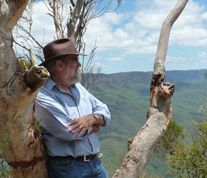
Jim Low is a singer/songwriter and published author.
His background is in education and he has also developed learning materials for the NSW Department of School Education. His passion is Australian history.
EMAIL: jim@jimlow.net WEBSITE: jimlow.net
